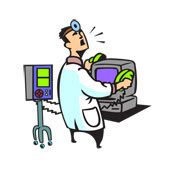
arthur@glazerthepctech.com
Microsoft has processes called services that assist the operating system and provide support to many applications. These services start automatically when Windows boots up and continue to run quietly in the background.
The thing is, they suck up system resources and there are many that you may not need. By terminating some superfluous services, you’ll speed up your computer considerably.
We’ll discuss turning some of them off, but realize that everybody’s system is different. What I may be able to disable, your computer may need. If you deactivate the wrong service, you’ll soon discover something in Windows won’t work any more.
The good news is that nothing is permanent. You can easily reactivate a service with a mouse click. I have 140 services running on my computer. Yours probably differs.
This list is not exhaustive by any means. You may find other services you don’t need. A word of caution: Don’t change too many at a time just in case your system has adverse reactions. This way you won’t have to hunt for the culprit and can just toggle a setting should something not function.
Before you start, create a restore point (Programs to Accessories to System Tools and System Restore) should something go wrong.
Go to the services area by clicking the Start button and in Run, type, services.msc and hit Enter. Under the Standard tab, you’ll see all the services, in alphabetical order, that run under Windows.
Double-click on each and a box will open to the General tab. Take the Alerter service, for example. When you open it, you’ll see a description of what it does, its startup type and its status. Mine is disabled and stopped.
You could alternatively put it on the Manual setting and stop it.
You don’t need Alerter. But to be certain, click the Dependencies tab at the top and see if anything in your system uses it. It deals with administrative alerts. If you use your computer at home, you won’t need it.
The next one is Clip Book. If you don’t deal with remote computers, you won’t need this one either. You could also be rid of Fast User Switching if you have only one account set up on your computer.
Error Reporting is nothing but a nuisance. Turn it off, too.
If you don’t log on to Help and Support, that’s another one you don’t need.
Indexing can speed up a file search, but it does it at the expense of system speed. So if you don’t do many file searches, you can turn off Indexing and speed up your system. Keep it and turn it on if you do search for files.
Next, Messenger works with clients, servers and networks and can be turned off if you are a home user. It has nothing to do with Windows Messenger and won’t affect it.
Performance Logs and Alerts is another rarely used service and can be safely shut down.
Routing and Remote Access allows remote connections to your computer. If you don’t allow remote access, that’s another one you won’t need.
Server, for the most part, can be terminated. Keep it only if you are on a home network and share printers or files. Otherwise, it won’t be missed.
Smart Card Service controls access to, yes, smart cards. If you don’t use them, you won’t need it. The same goes for the Smart Card Helper Service.
The Telephony Service deals with IP-based voice connections and fax use. Unless you use a phone or fax through your computer, you won’t need it.
Telnet will allow a remote user to log on to your computer. If you don’t let outside help access your PC and take it over, shut it down.
UPS or Uninterruptible Power Supply can be turned off if you don’t have one of those battery devices hooked up to your computer.
Windows Image Acquisition deals with images related to cameras and scanners. If you use neither with your computer, you can disable it. If you use Windows Movie Maker though, keep it turned on.
Wireless Zero is a must only if you connect via a wireless network. If you’re hard wired with an Ethernet cable, you can disable this one.
This is not a conclusive list. Windows has dozens of services and everybody’s computer is configured differently.
So research what you are about to terminate. You may need it.
Don’t panic if something doesn’t work after you make changes. Keep track of what you disabled and re-enable them one at time until your functionality returns. Also remember the restoration point you created, (you did make one, didn’t you?) should you need it.
The handful of services that you are able to terminate will make a difference. It will free up enough system resources to boost the overall speed of your computer.
Arthur Glazer is a freelance writer and computer technician in Gainesville. His column appears biweekly. Arthur welcomes your computer questions and ideas for future columns.

No comments:
Post a Comment
Got a Comment - or a quick question...